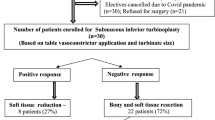Abstract
Atrophic rhinitis (AR) is a disease characterized by the extensive dilatation of the nasal cavity and atrophy of the mucosa, submucosa and bone tissue. Its etiological factors are unknown. There is not a satisfying treatment yet and the treatment of the functional impairment in the atrophic cells is still subject to investigation. The objective of this study is to determine at the histopathological level the possible effects of the submucosal fat injection in an experimental model of AR. 12 albino Wistar–Hannover male rats were included in the study. AR was induced with the Pasteurella multocida toxin, which was diluted with saline. As one of the rats died during the study, it was excluded from the evaluation. The right nasal cavities of all rats (11 nasal cavities) were defined as the control group (Group 1). Fat tissue obtained from the abdominal area was injected in the seven left nasal cavities (Group 2). All injections, which were done to the abdominal regions were also done in the left nasal cavities of the remaining four rats, which constituted the sham group (Group 3). After 14 days, all rats were decapitated and the squamous metaplasia and keratinization in the superficial epithelium, degeneration, vacuolar changes in the basal layer, congestion, inflammatory infiltration, vascular proliferation and glandular atrophy in the submucosa are histopathologically classified. The results were analyzed with statistical methods. Although glandular atrophy was significantly regressed in the fat injection group (Group 2) compared to other groups (p < 0.05), the remaining parameters did not show any significant difference among these three groups. The histopathological effect of the fat injection was modest. We concluded that fat injection treatment has no or at the most a very limited effect in the treatment of atrophic rhinitis.


Similar content being viewed by others
References
Mishra A, Kawatra R, Gola M (2012) Interventions for atrophic rhinitis. Cochrane Database Syst Rev. 2:CD008280
Garcia GJ, Bailie N, Martins DA, Kimbell JS (1985) Atrophic rhinitis: a CFD study of air conditioning in the nasal cavity. J Appl Physiol 2007(103):1082–1092
Hildenbrand T, Weber RK, Brehmer D (2011) Rhinitis sicca, dry nose and atrophic rhinitis: a review of the literature. Eur Arch Otorhinolaryngol 268:17–26
Kumar NS, Chandra TS (2008) Prosthetic management of atrophic rhinitis. Indian J Otolaryngol Head Neck Surg 60:379–381
Jaswal A, Jana AK, Sikder B, Nandi TK, Sadhukhan SK, Das A (2008) Novel treatment of atrophic rhinitis: early results. Eur Arch Otorhinolaryngol 265:1211–1217
Sajjad A (2011) A new technique for nasal stent fabrication for atrophic rhinitis: a clinical report. J Prosthodont 20:326–328
Goldenberg D, Danino J, Netzer A, Joachims HZ (2000) Plastipore implants in the surgical treatment of atrophic rhinitis: technique and results. Otolaryngol Head Neck Surg 122:794–797
Martineau-Doizé B, Dumas G, Larochelle R, Frantz JC, Martineau GP (1991) Atrophic rhinitis caused by Pasteurella multocida type D: morphometric analysis. Can J Vet Res 55:224–228
Sakano T, Okada M, Taneda A, Mukai T, Sato S (1997) Effect of Bordetella bronchiseptica and serotype D Pasteurella multocida bacterin-toxoid on the occurrence of atrophic rhinitis after experimental infection with B. bronchiseptica and toxigenic type AP. multocida. J Vet Med Sci 59:55–57
Wilson BA, Ho M (2011) Cellular and molecular action of the mitogenic protein-deamidating toxin from Pasteurella multocida. FEBS J 278:4616–4632
Wang WZ, Fang XH, Williams SJ, Stephenson LL, Baynosa RC, Wong N, Khiabani KT, Zamboni WA (2013) Analysis for apoptosis and necrosis on adipocytes, stromal vascular fraction, and adipose-derived stem cells in human lipoaspirates after liposuction. Plast Reconstr Surg. 131:77–85
Nakagami H, Morishita R, Maeda K, Kikuchi Y, Ogihara T, Kaneda Y (2006) Adipose tissue-derived stromal cells as a novel option for regenerative cell therapy. J Atheroscler Thromb 13:77–81
Parkins CS, Fowler JF, Yu S (1983) murine model of lip epidermal/mucosal reactions to X-irradiation. Radiother Oncol 1:159–165
Lee JY, Byun JY (2010) Primary atrophic rhinitis. Otolaryngol Head Neck Surg 143(4):601–602
Jordan RW, Roe JM (2004) An experimental mouse model of jorda rhinitis of swine. Vet Microbiol 103:201–207
Rohrbach S, Junghans K, Köhler S, Laskawi R (2009) Minimally invasive application of botulinum toxin A in patients with idiopathic rhinitis. Head Face Med 5:18
Bist SS, Bisht M, Purohit JP, Saxena R (2011) Study of histopathological changes in primary atrophic rhinitis. ISRN Otolaryngol 2011:269479
Umeno H, Shirouzu H, Chitose S, Nakashima T (2005) Analysis of voice function following autologous fat injection for vocal fold paralysis. Otolaryngol Head Neck Surg 132:103–107
Author information
Authors and Affiliations
Corresponding author
Ethics declarations
Conflict of interest
All the authors declare no conflict of interest.
Ethical approval
All applicable international, national, and/or institutional guidelines for the care and use of animals were followed.
Rights and permissions
About this article
Cite this article
Balur, M.B., Koçak, H.E., Altınay, S. et al. Is submucosal fat injection effective in atrophic rhinitis? An experimental animal study. Eur Arch Otorhinolaryngol 274, 3637–3642 (2017). https://doi.org/10.1007/s00405-017-4670-0
Received:
Accepted:
Published:
Issue Date:
DOI: https://doi.org/10.1007/s00405-017-4670-0




